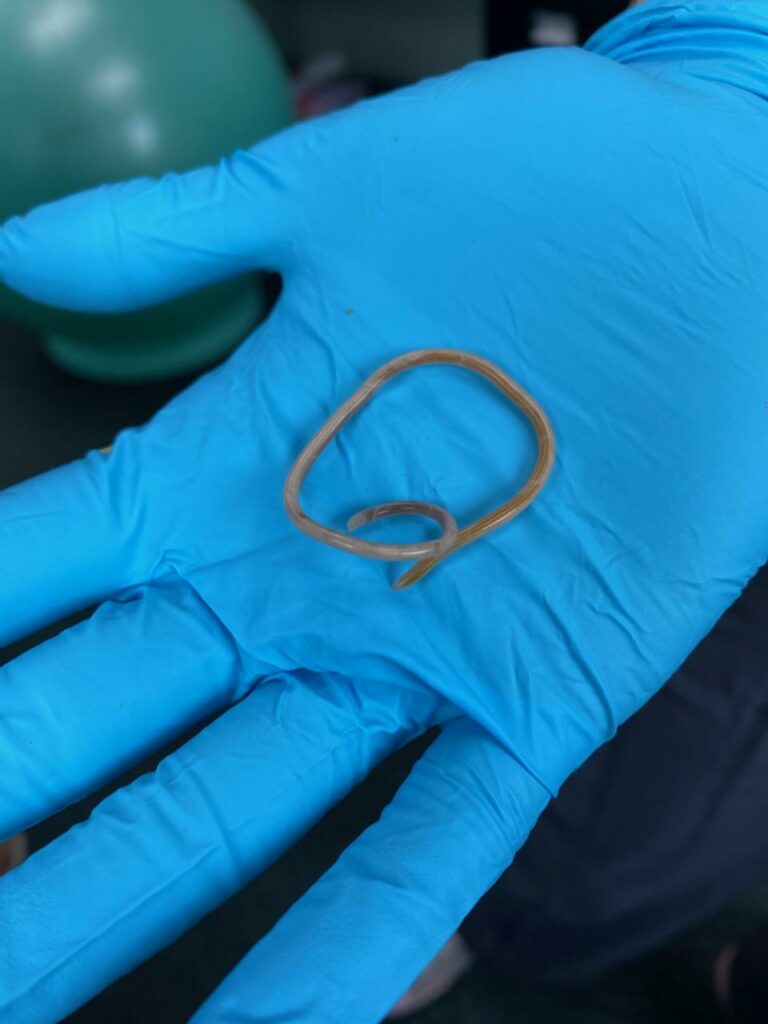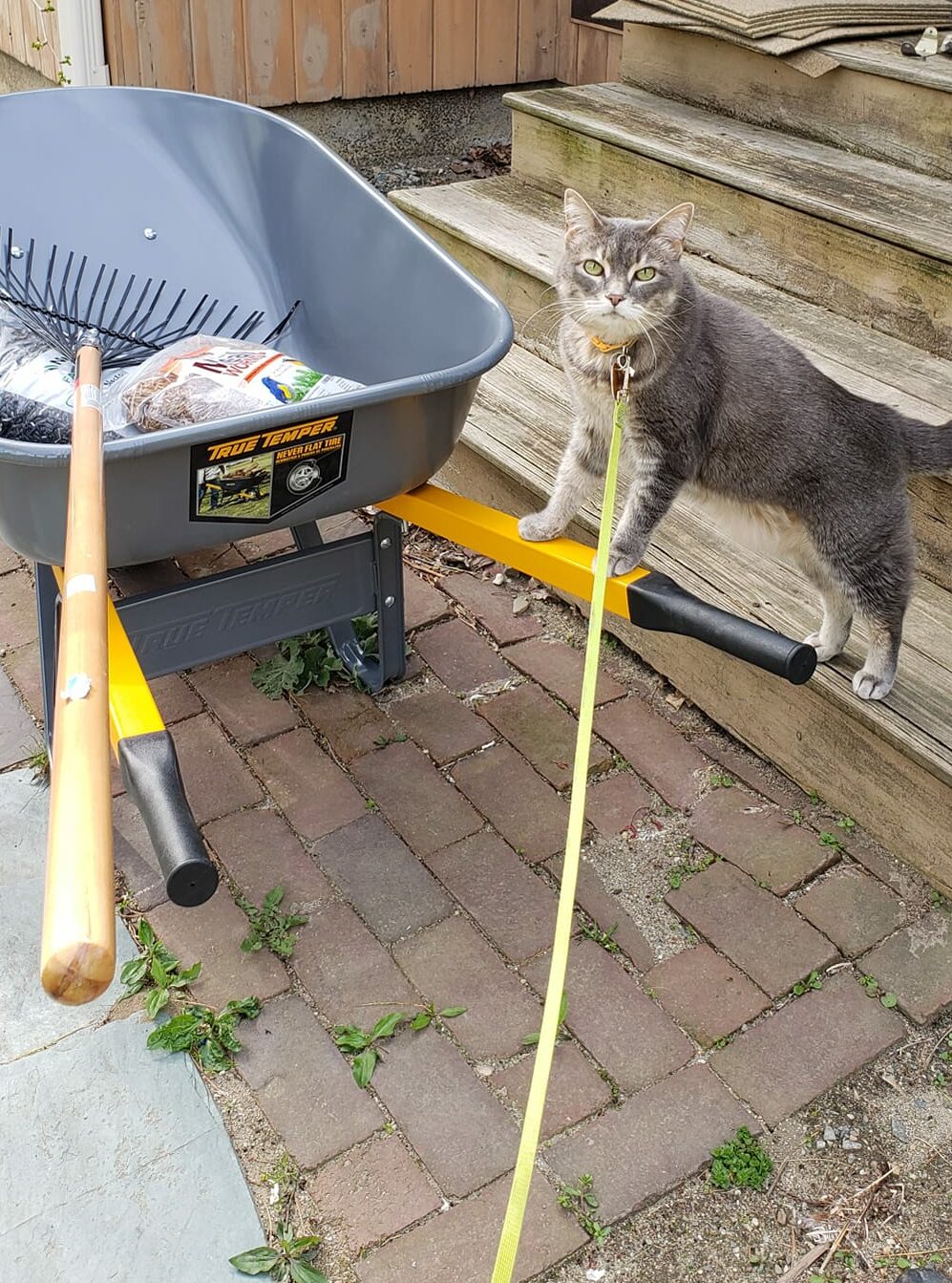Everyone who has ever owned a cat knows that they can be absolutely persistent once they want something. If that something is going outside, what should you do? What do you need to consider before letting your cat outdoors? Can you train your outdoor cat to stay inside? Are indoor cats even happy? We will discuss all of these and more in this month’s blog.
Please note that this article is addressing only pet cats, not working or barn cats. These cats have their own roles to play and are often outdoors to protect their families. Some cats cannot live inside because they lacked appropriate socialization as a kitten, and make wonderful working/barn cats! We are talking about pet cats, who snuggle up with you at night and don’t mind being coddled.

Are there benefits to letting my cat outside?
Although most veterinarians (including us at All Creatures Veterinary Hospital) do not recommend letting cats go outside, there are a few benefits. The primary benefit is keeping your cat entertained. Cats love to play, hunt and explore. We do not often meet these needs for indoor cats, without a little effort on the owner’s part (we will talk about this later!). Outdoor cats are less likely to be obese, which can reduce the risk of diabetes and arthritis.
Spayed and neutered outdoor cats can also outcompete feral cats for food and resources, which helps reduce feral cat populations. This is actually the idea behind Trap-Neuter-Return programs! They can continue to complete without continuing to contribute to the population.
The Many Dangers to an Outdoor Cat
The reason that veterinarians want your cat to be indoors is because we want to keep seeing him until he is 20 years old! Outdoor cats often have a shorter lifespan.
Coyotes
Other cats, coyotes, dogs, and cars will harm outdoor cats. Coyotes are great hunters and love a nice, rotund housecat. And who could blame them? Coyotes do carry rabies, unfortunately, so if your cat does survive a coyote attack, you must have him prophylactically vaccinated for rabies while your veterinarian is fixing his wounds. If he bites someone and does not survive, you will have to discuss sending him off for rabies testing (not to be too graphic, but we remove the head and send it to a state lab and leave the body behind). Especially if he is not up to date on his vaccine.
FeLV/FIV
Other cats also carry disease! Other feral or outdoor cats carry rabies (especially feral populations), but they also carry FIV (feline AIDS) and FeLV (a viral leukemia). Both of these diseases are transmitted by fighting between cats and are incurable. There is a vaccine for FeLV, but no vaccine is 100% effective. These diseases will slowly destroy your cat’s immune system. Many cats with FeLV/FIV live normal lives, but they are especially susceptible to diseases, and must be kept inside. They are also prone to dental disease and other forms of cancer later in life. The best treatment for FeLV and FIV is prevention! If your cat is already positive for one of these diseases, letting him outside again is risking the health of other cats.
Cars
If disease and other animals do not get to your outdoor cat, cars can! Many cats do survive being hit by cars, but have a lot of complications. Their bladder could rupture, their bones could break requiring amputation, and if they hit their head, the brain can swell. This all happens immediately on impact. Unfortunately, they are still critical days after the impact; their lungs could fill with fluid 2-3 days later. Treating a cat who has been hit by a car is expensive and difficult, at best.
Parasites
Outdoor cats are prone to parasite infestation, although any cat can be affected. The scariest parasite for your cat is actually heartworm disease, but this is very rare in cats. In cats that are unfortunate enough to become infected, it is a fatal disease. Much more common (and less scary) parasites are the roundworms, hookworms, and whipworms. Many of these are transmittable to humans, unfortunately, but they are easy to prevent and treat in our feline friends. Any broad spectrum parasite protection (e.g. Revolution Plus, Advantage Multi, Bravecto) will work to treat most of these parasites. If your cat goes outdoors, or is an indoor mouser, you should use these products year round to prevent worms!

Fleas and ticks are also a concern in cats. Thankfully, Lyme disease is rare in cats, but other tick borne diseases lead to red blood cell issues, fever, and sometimes death. They can be treated if caught early with a course of antibiotics (imagine one month of giving your cat a pill), but it is definitely easier to prevent these diseases. Fleas also carry tapeworms, which can be transmitted to you via your cat’s fleas. Gross!
Bartonella- a Human Concern
Another disease of particular importance is Cat Scratch Fever, or Bartonella. Bartonella is a disease that cats get when bitten by fleas. Once infected, cats are usually carriers/infected for life, and many do not have symptoms. But they can infect their humans! Bartonella is not directly transmissible between your cat and you, but if your cat has flea dirt (flea feces) in her nails, and accidentally scratches you, you can get the disease. Bartonella is especially important in people who are immunocompromised (AIDs, chemo patients, etc.). You will not catch Bartonella from a cat without fleas! The broad spectrum anti-parasite medications mentioned above do treat fleas, also, which is very convenient.
The World is a Buffet
This is true of both indoor and outdoor cats– but some cats will eat anything! Some risks are the same indoors and outdoors (e.g. hair ties, string and ribbons), but there are some toxins that are unique to the outside world. The most important one is lily plants. Lilies are incredibly toxic to cats. Even a small amount of pollen on her fur will cause renal failure when it is groomed off later. If you have an indoor cat, you just don’t bring lilies into your home. Unfortunately, you cannot control what flowers are planted in your neighbors’ yards. Antifreeze is similar; only a teaspoon on a paw will cause renal failure. A little bit on a road your cat is crossing can come back to haunt her that evening!
Many cats will hunt small animals outside. The easiest rodents to catch are the ones that are already sick from rodenticide. Rodenticide can be so potent that it can also affect your cat if she ingests a rat that has been poisoned. Indoor cats have this same problem, but they don’t catch as many (or any) rodents, so the risk is less.
Complications of Unrelated Diseases
Finally, if your cat develops irritable bowel disease (IBD), pancreatitis, or a food allergy later in life, she will need to be on a special diet with absolutely no deviations. Since most outdoor cats will hunt, you will not be able to control her disease without expensive medications, which may or may not work. You will have to start keeping her inside if she gets any of these issues as she gets older.
The Environmental Impact of Outdoor Cats
We love cats at All Creatures Veterinary Hospital, but we cannot deny that they are bad for the environment when outside. Cats are an invasive species, and are adapt at surviving in all environments where humans are found. Unfortunately, they are very good hunters, and are contributing to the extinction of many bird and rodent species. Some studies suggest that cats kill up to 7% of all birds in Canada each year. Cats likely caused 33 separate bird species’ extinctions, most notably on islands.
Cats also bring toxoplasmosis to an area. Toxoplasmosis is a parasitic infection that is somewhat common, more so in outdoor cats. This parasite is the reason that pregnant women are discouraged from cleaning litterboxes (although humans are more likely to get infected from undercooked pork than cats). Cats will ingest toxoplasmosis when hunting and eating rats and mice, and then spread it in their feces. Often cats are asymptomatic carriers, and so any cat introduced into an area can bring this disease. Two invasive species for the price of one!
Keeping your pet cat indoors will not change what feral cat populations eat, but one less cat on the streets is one less cat killing native wild animals. Remember, cats cannot distinguish between endangered and abundant rodents and birds!
Transitioning an Outdoor Cat to an Indoor Lifestyle
If your cat is already used to being outdoors, then you probably know the struggle of trying to keep him inside. Cats are relentless when they decide they want something, and any change of habit takes them a lot of time to adjust. Cats are also tricky– they tend to find a way out even when you do your best to keep them inside.
Meet in the Middle: Getting your Cat Safely Outdoors
If your cat really does enjoy being an outdoor cat, and will not let you do anything else until she is satisfied, consider building a “catio”. Catios are enclosed areas of your porch or yard, completely surrounded by screens, so predators and other cats cannot come in, and your cat cannot get out. Catios are a great way to let your cat get some fresh air, sunshine, and mental stimulation without all the dangers. We recommend supervision, still, as cats can break out of screens. Many cats are happy to be sitting in a catio. You can plant cat grass, catnip, and other cat safe plants in your catio to keep your cat busy and give her places to “hide”. A bird feeder outside of the catio provides her with a little bit of television, while keeping the birds safe, too!
Cats can be trained to walk on a leash. It does take a lot of time and patience, but some cats love being on a leash. You have to start by slowly (with lots of treats) getting her used to a harness or collar that you choose to use, and then gradually introducing her to the outside world. Having her tied to you will help reduce the risk of other cats and predators from coming up to her, but ticks and fleas are still a concern, so please keep her on a monthly preventive! Cats do not usually enjoy long distance walks, but often prefer to sniff and play under bushes. Bring something to read.

Can I just keep my cat indoors?
Yes! You can just keep your cat indoors. Spayed and neutered cats have less of a desire to roam, making it easier to keep him inside. It is also easiest to start keeping him inside in the winter, when he likely does not want to go outside as often anyways. It takes a strong willpower to keep an outdoor cat inside. He will ask to go out for up to a year before you break that habit. You can help distract him with randomized treat dispensers, puzzle toys, and lots of play time.
Reward him when he steps away from the door, so he starts to associate being away from the door with good feelings. This will be a hard, long year as an owner. But please do not give up! Keeping your cat indoors is a good way to increase their lifespan and prevent them from pain and injuries. The extra play time may add to your bond, too.
The Indoor Pet Initiative is a great resource for all things cat behavior, and they have many tips and tricks for keeping your cat indoors. Please read more about them here!
https://indoorpet.osu.edu/cats/basic-indoor-cat-needs
Please call us at All Creatures Veterinary Hospital today to talk about keeping your cat indoors, vaccines, and parasite preventives!








